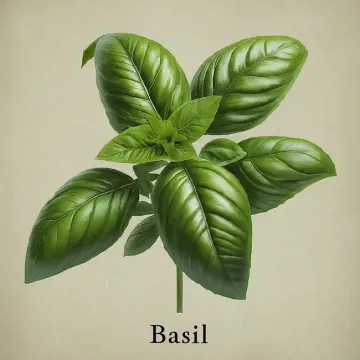Basil (Ocimum basilicum) is a beloved herb that has been cultivated for thousands of years, prized for its aromatic leaves and versatility in cooking. This article will explore the history of basil, its health benefits, culinary uses, and provide practical tips for growing this herb in your home garden.
History of Basil
Basil's history is as rich and varied as its flavor. Originating in tropical regions of Central Africa and Southeast Asia, basil has been cultivated for over 5,000 years. It was first introduced to Europe through ancient trade routes, where it quickly became a staple in Mediterranean cuisine.
The name "basil" is derived from the Greek word "basilikos," meaning "royal" or "kingly." In ancient Greece, basil was associated with royalty and was believed to have protective properties. In India, basil is considered a sacred herb in Hinduism and is often planted around temples.
Throughout history, basil has been used not only in cooking but also in medicine and religious ceremonies. It was believed to ward off evil spirits, and in medieval Europe, it was used to treat various ailments, including digestive disorders and insect bites.
Health Benefits of Basil
Basil is not only a flavorful addition to dishes but also a source of several health benefits:
- Rich in Antioxidants: Basil is packed with antioxidants, which help protect the body from oxidative stress and reduce inflammation.
- Anti-inflammatory Properties: The essential oils in basil, such as eugenol, have anti-inflammatory effects, which can help reduce the risk of chronic diseases like heart disease and arthritis.
- Supports Digestive Health: Basil can aid digestion by reducing bloating, gas, and cramping. It also helps to stimulate appetite and can alleviate indigestion.
- Boosts Immunity: The essential oils and vitamins found in basil, including vitamin C, support the immune system, helping the body fight off infections.
- Promotes Mental Health: Basil contains adaptogenic properties that can help reduce stress and anxiety, promoting overall mental well-being.
Culinary Uses of Basil
Basil is a cornerstone of many culinary traditions, especially in Mediterranean and Southeast Asian cuisines. Here are some popular uses:
- Pesto: One of the most famous uses of basil is in pesto, a traditional Italian sauce made with fresh basil leaves, pine nuts, garlic, Parmesan cheese, and olive oil. Pesto can be used as a sauce for pasta, a spread for sandwiches, or a topping for vegetables.
- Salads: Fresh basil leaves add a burst of flavor to salads, especially when paired with tomatoes and mozzarella in the classic Caprese salad.
- Soups and Sauces: Basil is a key ingredient in many soups and tomato-based sauces, adding a fresh, aromatic flavor.
- Herb Infused Oils and Vinegars: Basil can be infused in oils and vinegars to create flavorful dressings and marinades.
- Herbal Teas: Basil leaves can be used to make soothing herbal teas, often combined with other herbs like mint or lemon balm.
Growing Tips for Basil
Basil is a relatively easy herb to grow, making it a favorite for home gardeners. Here are some tips to help you cultivate a healthy basil plant:
- Choose the Right Variety: There are many varieties of basil, including sweet basil, Thai basil, and purple basil. Choose the variety that best suits your culinary needs.
- Planting: Basil thrives in warm weather and should be planted after the last frost in spring. It can be grown from seeds or transplants. If starting from seeds, sow them indoors 6-8 weeks before the last frost date.
- Sunlight: Basil requires plenty of sunlight—at least 6-8 hours of direct sunlight each day. If growing indoors, place the plant near a sunny window.
- Soil: Basil prefers well-drained, nutrient-rich soil. Ensure the soil is moist but not waterlogged. Adding compost can improve soil quality.
- Watering: Keep the soil consistently moist, but avoid overwatering. Water the plant at the base to prevent the leaves from getting wet, which can lead to fungal diseases.
- Pruning: Regularly pinch off the top leaves of the basil plant to encourage bushier growth and prevent the plant from flowering too early. Flowering can make the leaves taste bitter.
- Pests and Diseases: Basil can be affected by pests like aphids and diseases like downy mildew. Regular inspection and prompt treatment with organic pest control methods can keep your plant healthy.
- Harvesting: Harvest basil leaves regularly to encourage new growth. The best time to harvest is in the morning when the leaves are most flavorful. Store fresh basil in a glass of water at room temperature or freeze the leaves for long-term use.
Conclusion
Basil is a versatile and aromatic herb that brings both flavor and health benefits to the table. With its rich history, numerous culinary uses, and relatively easy cultivation, basil is a must-have in any home garden. By following the growing tips outlined above, you can enjoy a bountiful harvest of fresh basil all season long, enhancing your dishes with the taste of summer.

